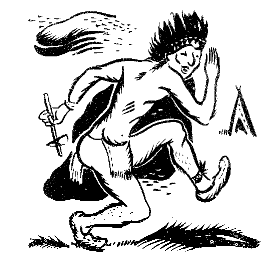California Indian Genocide - Disappearance of the Natives
From a high population of 300,000 before contact, Indians in California reached a low of 16,000 in 1900. According to Alvin M. Josephy in his book 500 Nations, the history of the California tribes "was as close to genocide as any tribal people had faced, or would face, on the North American continent." Indian Country Diaries, PBS.org
While it is not the intent of this website to discuss the overall history of California, the plight of the Stanislaus area tribes affects the history of Stanislaus County and the Modesto area. Early recognition of the treatment of Indians in the area is pinpointed in the book, "Stories of Stanislaus" by Sol P. Elias, one of the early Modesto historians and a member of Modesto High School's first graduating class. Elias, who later became mayor of Modesto, makes the following statement in the 1924 book:
"The story of the Indians of Stanislaus county is pathetic. It records the contest of two peoples for the soil of the new country. It is indeed the epic of the races in the wilderness of the plains."
Elias says that by 1924 the natives who "occupied the virgin valley of the San Joaquin and the foothills of the Sierras have died out completely." He says that 50 years before, which would have been 1874, "a miserable remnant of the tribes existed in a primitive condition at Knight's Ferry and a few in the foothills about La Grange. . .they could be seen paddling their frail canoes up and down the Tuolumne and the Stanislaus rivers in search of acorns and game."
It is unusual to see the following criticism voiced almost 100 years ago, but Elias is blunt in his commentary: "Numerous in the 40s, when the lure of gold attracted the Argonauts, the cupidity and the land lust of the miners and the immigrants and the apathetic negligence of the United States have pushed the Indians of Stanislaus from the face of the earth."
Cleansing History
Thirty years later, Stanislaus County Schools, under County Superintendent Fred C. Beyer, included the following about Stanislaus area Native Americans in "Stanislaus County - 1854 to 1954, 100 Years of Progress":
"The campaign that followed the failure of the council of Knights Ferry lasted over a year. During this time the American Forces followed the Indians into the hills capturing and killing."
The reference to the failed council refers to an attempt to have Indian tribes agree to peace terms, but it was believed "the Indians were hostile and refused to come to the council. It was decided, then, that the tribes would have to be subdued by force."
In 1851, "a treaty of peace was drawn up between the Indians and the federal government." Unfortunately, when this and several other treaties were presented to the US Senate, they were all rejected. The publication states, "All the promises made to the Indians at Knights Ferry went unfilled."
Clearly of its time, the conclusion drawn by the writers of this publication about the Indians of Stanislaus County and their subsequent demise is highly prejudiced in light of today's knowledge and standards, and is presented here only for historical context:
"The life of the California Indian in Stanislaus County was a sorry one. In his original state the native endured a sub-human existence. His association with the whites did not improve his lot. Poverty, disease, neglect and whiskey all took their toll. Siince May of 1851 the Indians of six tribes in Stanislaus County have gradually disappeared."
Next: Early History/Early Days/Early Regional History
Previous: Early Days/Natives of Stanislaus/Chief Estanislao

